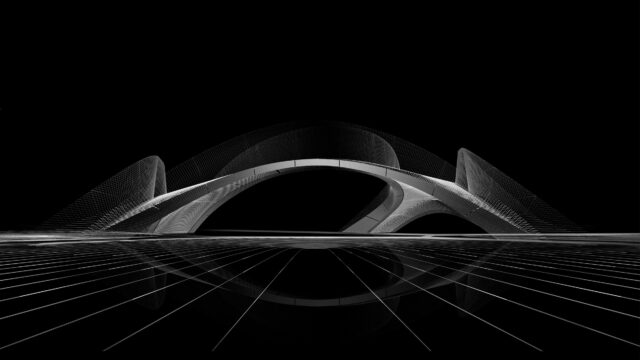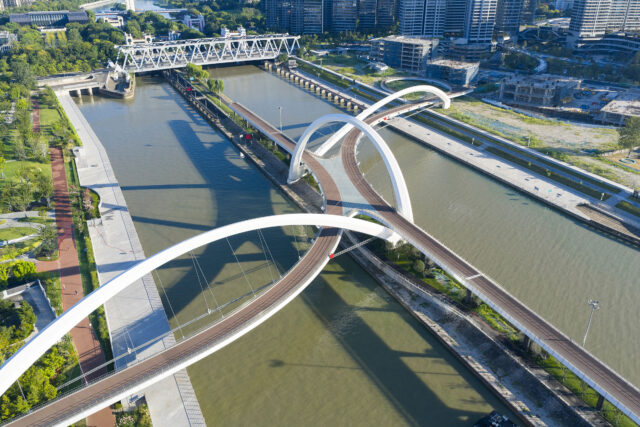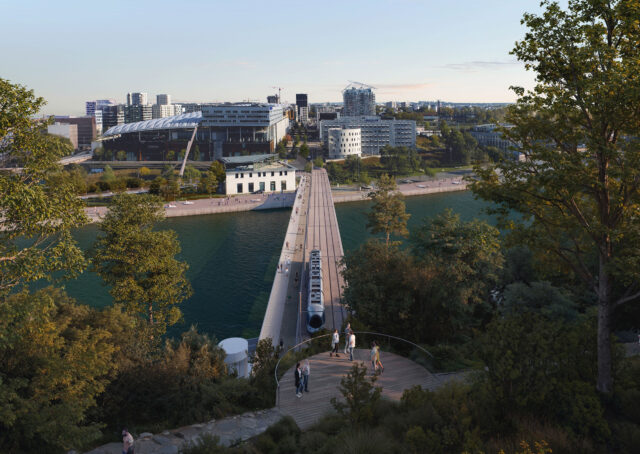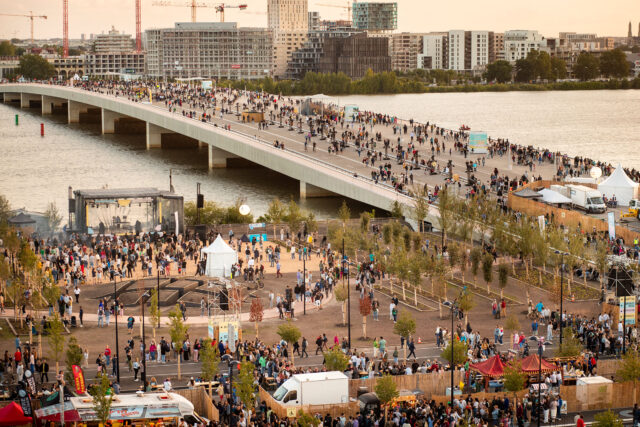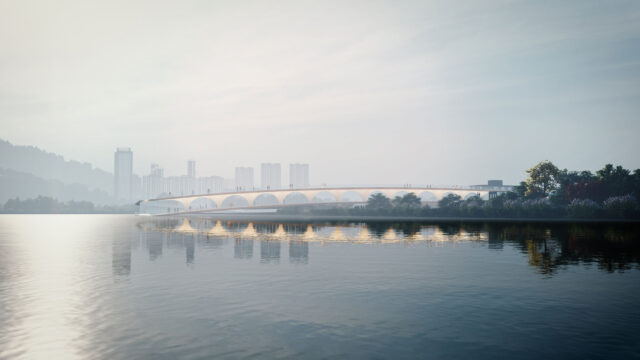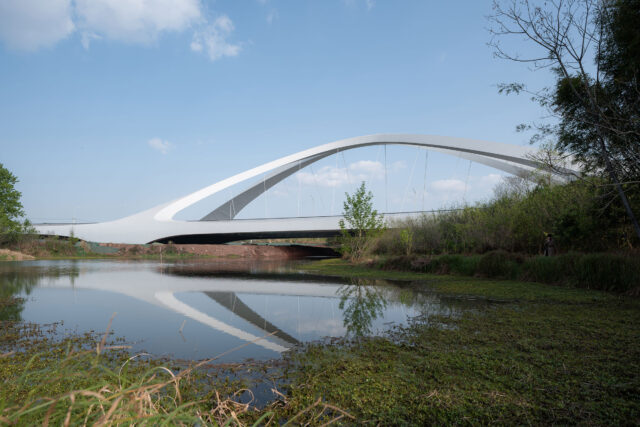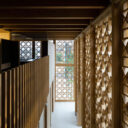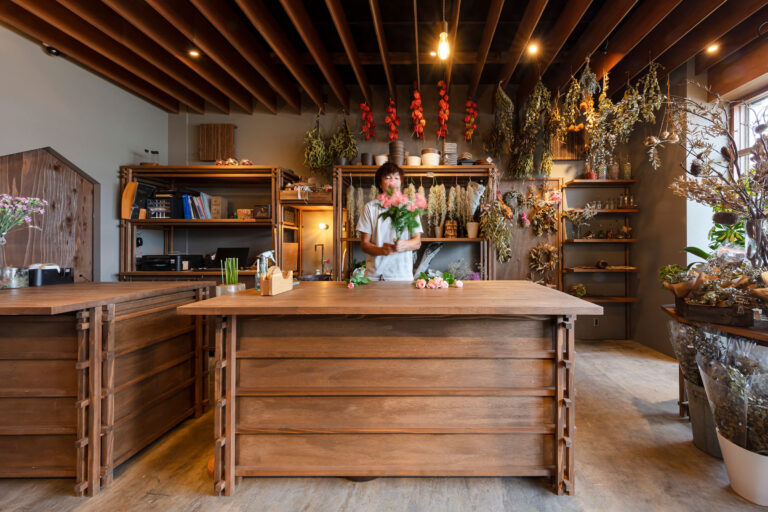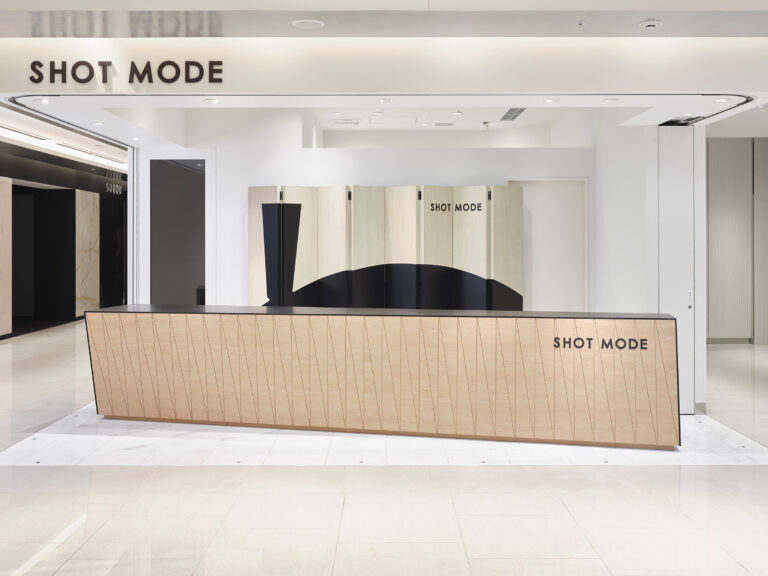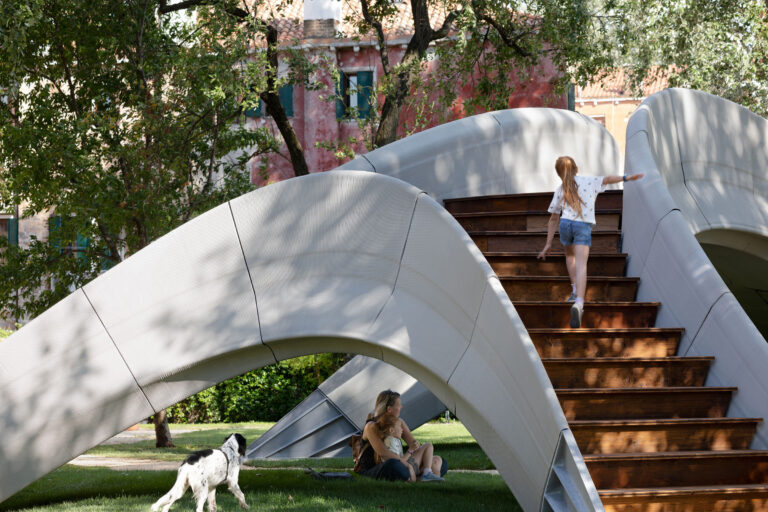
SHARE ザハ・ハディド・アーキテクツ、ETHZ、incremental3Dによる、3Dプリントコンクリートで作られたアーチ型の組積造の橋「Striatus」。テクノロジーによってサステナブル性が追求された本作の、図面や施工プロセス写真も豊富に掲載



ザハ・ハディド・アーキテクツ、ETHZ(スイス連邦工科大学チューリッヒ校)、incremental3Dによる、3Dプリントコンクリートで作られたアーチ型の組積造の橋「Striatus」です。テクノロジーによってサステナブル性が追求された本作の、図面や施工プロセス写真も豊富に掲載します。
こちらはリリーステキストを抜粋して翻訳したもの
Striatusは、3Dプリントされたコンクリートブロックを、モルタルや補強材を使わずに組み立てたアーチ型の組積造歩道橋です。16×12メートルのこの歩道橋は、伝統的な施工者の技術と、高度なコンピュータデザイン、エンジニアリング、ロボット製造技術を組み合わせた、世界初の作品です。
2021年11月まで開催されるヴェネツィア・ビエンナーレ国際建築展の会場(Giardini della Marinaressa)に展示されるStriatusは、スイス連邦工科大学チューリッヒのBlock Research Group(BRG)とザハ・ハディド・アーキテクツのコンピューテーション・アンド・デザイン・グループ(ZHACODE)が、incremental3D(in3D)と共同で開発したもので、Holcim社の協力を得て実現しました。
Striatusは、石積み構造、3Dコンクリートプリント(3DCP)、現代的なデザインの特性を最適化し、従来のコンクリート建築に代わるものを提案しています。Striatusという名前は、その構造論理と製造プロセスを反映しています。コンクリートは、主な構造力と直交する層に精密に印刷され、モルタルや補強材を必要としない「筋状」の圧縮のみの構造を作り出します。
モルタルを必要としない構造のため、ブロックを解体し、別の場所で橋を組み立てることができます。また、構造が不要になった場合は、材料を分離してリサイクルすることができます。
形状による強度
Striatusは、幾何学的な構造によって強度を得る無筋コンクリート構造です。コンクリートは人造石のようなもので、圧縮されたときに最も優れた性能を発揮します。アーチ型やヴォールト型の構造では、材料を正確に配置することで、純粋に圧縮された状態で支持部に力が伝わります。従来のコンクリートの梁や平板の床スラブのように、材料を非効率的に積み重ねるのではなく、形状によって強度を生み出します。これにより、空間を横断するのに必要な材料の量を大幅に削減できるだけでなく、より低強度で低公害の代替品を使用して構築することが可能になります。
Striatusの二分されたデッキの形状は、その土地の条件に対応しています。その構造的なアーチの索形状は、もともと歴史的な石積みのアーチの構造評価のために開発されたスラストネットワーク解析などの限界解析技術や平衡法によって定義されており、その三日月形の輪郭は、すべての荷重ケースにおいて構造体を通る圧縮力を示す推力線を包含しています。
アーチの水平方向の推力をスチール製のテンションタイが吸収します。乾式で組まれたブロックの間にネオプレンパッドを配置することで、応力の集中を避け、界面の摩擦特性をコントロールしています。これは、歴史的な石造建築で鉛シートやソフトモルタルが使用されていたことと同じです。
平面的には、構造体の境界は深いアーチを形成しており、水平荷重(例えば、手すりにもたれかかる来場者の荷重)を純粋な圧縮で支持体に伝えています。高度な離散要素モデリング(DEM)を用いて、ブロックのステレオトミーを改良・最適化し、極端な負荷条件やサポートの差動沈下に対する組み立て全体の安定性を確認しました。
サーキュラー・バイ・デザイン
循環型デザインのStriatusは、必要な場所にのみ材料を配置し、環境への影響を大幅に軽減します。補強材を使用せず、結合剤を使用しない乾式組立で作られたStriatusは、設置、解体、再組み立て、再利用を繰り返すことができ、サステナビリティの3つのR(Reduce、Reuse、Recycle)をコンクリート構造に適用できることを示しています。
リサイクル
異なる材料を確実に分離することで、Striatusの各コンポーネントは、最小限のエネルギーとコストで容易にリサイクルすることができます。また、3Dプリントにより、使い捨ての金型に伴う廃棄物やコストを回避することができます。さらに、Striatusの構成材料は、化学接着剤やバインダーではなく、せり石間の単純な乾式接続のような機械的接続を使用することで、分離可能な状態を維持しています。これにより、要素の寿命が尽きたときに、シンプルで低エネルギーのリサイクルプロセスが保証されます。
ロボットによる3Dコンクリートプリント
Striatusは、一般的な押出成形による単純な水平層の3Dプリントとは異なり、2成分(2K)のコンクリートインクとそれに対応するプリントヘッドおよびポンプの配置を用いて、6軸、多自由度のロボットアームを介して、不均一で平行でない層を正確にプリントします。この新世代の3Dコンクリートプリントとアーチ型の石積みデザインを組み合わせることで、補強やポストテンションなしで構造的に使用することができます。
以下の写真はクリックで拡大します





























以下、リリーステキストです。
Striatus
An arched 3D-concrete-printed masonry bridge
Striatus is an arched masonry footbridge composed of 3D-printed concrete blocks assembled without mortar or reinforcement. The 16 x 12 metre footbridge is the first of its kind, combining traditional techniques of master builders with advanced computational design, engineering and robotic manufacturing technologies.
Exhibited at the Giardini della Marinaressa during the Venice Architecture Biennale until November 2021, Striatus has been developed by the Block Research Group (BRG) at ETH Zurich and Zaha Hadid Architects Computation and Design Group (ZHACODE), in collaboration with incremental3D (in3D) and made possible by Holcim.
Proposing a new language for concrete that is structurally informed, fabrication aware, ecologically responsible and precisely placed to build more with less, Striatus optimises the properties of masonry structures, 3D concrete printing (3DCP) and contemporary design; presenting an alternative to traditional concrete construction.
The name “Striatus” reflects its structural logic and fabrication process. Concrete is precisely printed in layers orthogonal to the main structural forces to create a “striated” compression-only structure that requires no mortar or reinforcement.
As the construction does not need mortar, the blocks can be dismantled, and the bridge reassembled at different location. If the construction is no longer needed, the materials can simply be separated and recycled.
Strength through geometry
Striatus is an unreinforced concrete structure that achieves strength through geometry. Concrete can be considered an artificial stone that performs best in compression. In arched and vaulted structures, material can be placed precisely so that forces can travel to the supports in pure compression. Strength is created through geometry, rather than an inefficient accumulation of materials as in conventional concrete beams and flat floor slabs. This presents opportunities to significantly reduce the amount of material needed to span space as well as the possibility to build with lower-strength, less-polluting alternatives.
Striatus’ bifurcating deck geometry responds to its site conditions. The funicular shape of its structural arches has been defined by limit analysis techniques and equilibrium methods, such as thrust network analysis, originally developed for the structural assessment of historic masonry vaults; its crescent profile encompasses the thrust lines that trace compressive forces through the structure for all loading cases.
Steel tension ties absorb the horizontal thrust of the arches. Neoprene pads placed in between the dry-assembled blocks avoid stress concentrations and control the friction properties of the interfaces, echoing the use of lead sheets or soft mortar in historical masonry construction.
In plan, the boundaries of the structure form deep arches that transfer horizontal loads (for example, from visitors leaning against the balustrades) to the supports in pure compression. Advanced discrete element modelling (DEM) was used to refine and optimise the blocks’ stereotomy and to check stability of the entire assembly under extreme loading cases or differential settlements of the supports.
The bridge’s 53 3DCP voussoirs have been produced using non-parallel print layers that are orthogonal to the dominant flow of forces. This avoids delamination between the print layers as they are held together in compression. The additive manufacturing process ensures the structural depth of the components can be achieved without producing blocks with a solid section, hence reducing the amount of material needed compared to subtractive fabrication methods or casting.
Striatus follows masonry structural logic on two levels. As a whole, the bridge behaves as a series of leaning unreinforced voussoir arches, with discretisations orthogonal to the dominant flow of compressive forces, following the same structural principles as arched Roman bridges in stone. Locally, on the level of the voussoir, the 3DCP layers behave as traditional brick masonry evident in the inclined rows of bricks within Nubian or Mexican vaulting.
Circular by design
Circular by design, Striatus places material only where needed, significantly reducing its environmental footprint. Built without reinforcement and using dry assembly without binders, Striatus can be installed, dismantled, reassembled and repurposed repeatedly; demonstrating how the three R’s of sustainability (Reduce, Reuse, Recycle) can be applied to concrete structures.
Reduce:
– Lowering embodied emissions through structural geometry and additive manufacturing that minimises the consumption of resources and eliminates construction waste.
– Placing concrete only there where needed, 3DCP minimises the amount of material required, while the low-stress, compression-only funicular geometry of Striatus proposes the further development of 3DCP that will enable the use of much lower-strength, less-polluting printable materials.
– Compared to embedded reinforcement in concrete, Striatus uses external ties to absorb the thrust of its arched shape and dramatically reduce the amount of steel required. A high carbon-intense material, steel reinforcement (100% recycled) per unit mass is more than ten times that of a standard concrete.
Reuse:
– Improving circularity and longevity. Unlike conventional reinforced concrete structures, Striatus is designed to be dry assembled without any binder or glue, enabling the bridge to be dismantled and reused in other locations. Its funicular design ensures the 3DCP blocks experience low stresses throughout their use, resulting in no loss of structural integrity. Striatus separates components in compression and tension, ensuring external ties can be easily accessed and maintained, resulting in a longer lifespan for the entire structure.
Recycle:
– By ensuring different materials are separated and separable, each component of Striatus can easily be recycled with minimal energy and cost. 3D printing also avoids the waste and costs associated with single-use moulds. Additionally, the component materials within Striatus remain separate and separable with the use of mechanical connections such as simple dry contacts between the voussoirs rather than chemical glues or binders, ensuring a simple, low-energy recycling process at the end of the elements’ life, potentially after multiple cycles of reuse.
Robotic 3D concrete printing
Unlike typical extrusion 3D printing in simple horizontal layers, Striatus uses a two-component (2K) concrete ink with corresponding printing head and pumping arrangement to precisely print non-uniform and non-parallel layers via a 6-axis, multi-DOF robotic arm. This new generation of 3D concrete printing in combination with the arched masonry design allows the resulting components to be used structurally without any reinforcement or post-tensioning.
To prevent misalignment between the direction of structural forces and the orientation of material layers that arises from typical shape-agnostic slicing of explicitly modelled geometry, a custom-developed design pipeline was formulated for Striatus to ensure that its printed layers are wholly aligned with the direction of compression forces throughout the entire bridge and also locally through each 3D-printed block. To address issues and challenges that could prevent in-between stability during printing, the coherence and feasibility of the gradually evolving print paths have been modelled using a Functional Representation (FRep) process.
This process encodes and continuously checks rules of minimum overlap, maximum cantilever between print layers and print length, print speed and the volume of wet concrete extruded. These measures, typically used in horizontally layered 3DCP, have been advanced and refined to work on an inclined-plane setting:
– The angular differences between start and end planes of all 53 printed blocks have been simultaneously adjusted to meet multiple criteria such as an appropriate structural contact and angle between adjacent blocks, and maximum print inclination.
– The careful design and iterative refinement of the hollow cross sections and infill triangulation have ensured that material is placed corresponding to the precisely analysed, local structural performance of each block. This design and optimisation has been applied to each individual layer of every block (with 500 print layers on average per block), ensuring that all blocks are as hollow and light as possible, and consequently use the least amount of material possible, while maintaining structural integrity under all loading conditions.
– The resulting intricate cross-sectional design has been processed into a single, continuous print path meeting various criteria that include appropriate print speed and turning radii, structurally required material width and thickness, and controlled expression of naturally occurring printing artefacts.
A nuanced aspect of robotic 3DCP masonry is the re-introduction of intelligence and highly skilled labour into the manufacturing and construction industry. The digitisation of fabrication and digital augmentation of skilled assembly and construction techniques makes historically-accrued knowledge accessible to younger generations and enables its systematic upgrade towards industrialised construction through the use of computational and robotic technologies. In stark contrast to a brute force, and often materially wasteful economy biased towards automation and assembly line production, 3DCP masonry introduces possibilities of a symbiotic human-machine economy. This promises an environmentally, socio-culturally and economically sustainable alternative to its 20th-century predecessor.
Computational design-to-construction integration
Integrating design, engineering, fabrication and construction, Striatus redefines conventional interdisciplinary relations. The precise manufacturing of the blocks was enabled by well-defined data exchange between the various domain-specific software toolchains involved in the process. This co-development approach was facilitated through the use of COMPAS, an open-source computational framework for collaboration and research in the AEC industry, which enabled the fluent interaction among the key players of the project, working together in five different countries, under a very tight schedule and budget, at a time in which travelling was not possible.
Disruptive outlook
Striatus offers a blueprint for building more with less. Created with the same structural principles and a similar fully-integrated computational design-to-fabrication approach that form the basis of the vaulted, rib-stiffened, unreinforced concrete floors being developed by the Block Research Group in partnership with Holcim, Striatus proposes an alternative to the standard inefficient floor slabs within any building.
Compared to typical reinforced-concrete flat floor slabs, this new floor system uses only 30% of the volume of concrete and just 10% of the amount of steel. The very low stresses within the funicular structure also enable the use of low-embodied-carbon concrete that incorporates high percentages of recycled construction waste. Prefabricated and dry-assembled, and therefore fully demountable and reusable, this floor system is easily and cleanly recyclable at end-of-life.
With an estimated 300 billion square metres of floor area to be constructed worldwide over the next 30 years, and floors comprising more than 40% of the weight of most high-rise buildings (10+ storeys), introducing the principles demonstrated by Striatus would truly disrupt the construction industry — transforming how we design and construct our built environment to address the defining challenges of our era.
This process encodes and continuously checks rules of minimum overlap, maximum cantilever between print layers and print length, print speed and the volume of wet concrete extruded. These measures, typically used in horizontally layered 3DCP, have been advanced and refined to work on an inclined-plane setting:
– The angular differences between start and end planes of all 53 printed blocks have been simultaneously adjusted to meet multiple criteria such as an appropriate structural contact and angle between adjacent blocks, and maximum print inclination.
– The careful design and iterative refinement of the hollow cross sections and infill triangulation have ensured that material is placed corresponding to the precisely analysed, local structural performance of each block. This design and optimisation has been applied to each individual layer of every block (with 500 print layers on average per block), ensuring that all blocks are as hollow and light as possible, and consequently use the least amount of material possible, while maintaining structural integrity under all loading conditions.
– The resulting intricate cross-sectional design has been processed into a single, continuous print path meeting various criteria that include appropriate print speed and turning radii, structurally required material width and thickness, and controlled expression of naturally occurring printing artefacts.
A nuanced aspect of robotic 3DCP masonry is the re-introduction of intelligence and highly skilled labour into the manufacturing and construction industry. The digitisation of fabrication and digital augmentation of skilled assembly and construction techniques makes historically-accrued knowledge accessible to younger generations and enables its systematic upgrade towards industrialised construction through the use of computational and robotic technologies. In stark contrast to a brute force, and often materially wasteful economy biased towards automation and assembly line production, 3DCP masonry introduces possibilities of a symbiotic human-machine economy. This promises an environmentally, socio-culturally and economically sustainable alternative to its 20th-century predecessor.
Computational design-to-construction integration
Integrating design, engineering, fabrication and construction, Striatus redefines conventional interdisciplinary relations. The precise manufacturing of the blocks was enabled by well-defined data exchange between the various domain-specific software toolchains involved in the process. This co-development approach was facilitated through the use of COMPAS, an open-source computational framework for collaboration and research in the AEC industry, which enabled the fluent interaction among the key players of the project, working together in five different countries, under a very tight schedule and budget, at a time in which travelling was not possible.
Disruptive outlook
Striatus offers a blueprint for building more with less. Created with the same structural principles and a similar fully-integrated computational design-to-fabrication approach that form the basis of the vaulted, rib-stiffened, unreinforced concrete floors being developed by the Block Research Group in partnership with Holcim, Striatus proposes an alternative to the standard inefficient floor slabs within any building.
Compared to typical reinforced-concrete flat floor slabs, this new floor system uses only 30% of the volume of concrete and just 10% of the amount of steel. The very low stresses within the funicular structure also enable the use of low-embodied-carbon concrete that incorporates high percentages of recycled construction waste. Prefabricated and dry-assembled, and therefore fully demountable and reusable, this floor system is easily and cleanly recyclable at end-of-life.
With an estimated 300 billion square metres of floor area to be constructed worldwide over the next 30 years, and floors comprising more than 40% of the weight of most high-rise buildings (10+ storeys), introducing the principles demonstrated by Striatus would truly disrupt the construction industry — transforming how we design and construct our built environment to address the defining challenges of our era.



